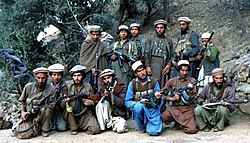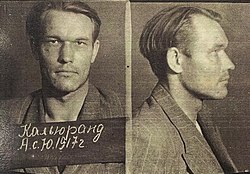Resistance movement
A resistance movement is an organized movement by some portion of the civil population of a country to fight against an occupying power and to cause civil disorder. Sometimes they could be a nonviolent resistance (sometimes called civil resistance), or the use of force.
In many cases, as for example in Norway in the Second World War, a resistance movement may have had both violent and non-violent methods.[1]
Resistance Movement Media
Members of the Norwegian resistance movement Milorg, engaged in supply raids, espionage as well as the sabotage of German heavy water production during WW2
A group of Afghan mujahideen, who were considered to be freedom fighters by Western nations, October 1987
Mugshot of Ants "the Terrible" Kaljurand, a famous Estonian freedom fighter and Nazi collaborator
The Vendeans revolted against the revolutionary government in France in 1793
Greek War of Independence, (1821–29), rebellion of Greeks within the Ottoman Empire, a struggle which resulted in the establishment of an independent Greece.
Three Filipino Moro rebels hanged by the Americans in Jolo during the Moro Rebellion
Omar Mukhtar led Libyan Mujahidin against the imperialist forces of Fascist Italy
Algerian National Liberation Army during the Algerian War against French occupation
Notes
- ↑ On the relation between military and civil resistance in occupied Norway 1940–45, see Magne Skodvin, "Norwegian Non-violent Resistance during the German Occupation", in Adam Roberts (ed.), The Strategy of Civilian Defence: Non-violent Resistance to Aggression, Faber, London, 1967, pp. 136–53. (Also published as Civilian Resistance as a National Defense, Harrisburg, US: Stackpole Books, 1968; and, with a new Introduction on "Czechoslovakia and Civilian Defence", as Civilian Resistance as a National Defence, Harmondsworth, UK/Baltimore, US: Penguin Books, 1969. ISBN 0-14-021080-6.)









